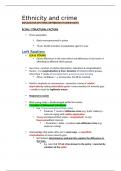Class notes
A* student detailed notes on ethnicity and crime
- Course
- Institution
- Book
A* student well written and detailed notes on ethnicity and crime, including theory such as left realism, neo-Marxism… etc, and with name of sociologists, such as Lea and Young , Gilroy…etc. The notes are in PEEEL structure, where theories are analysed and explained in detail with examples, but...
[Show more]




